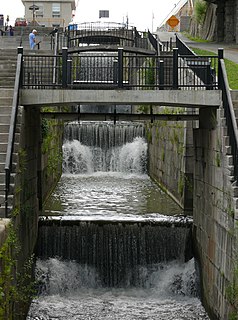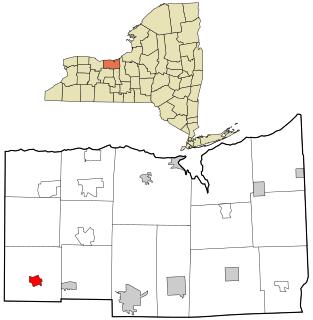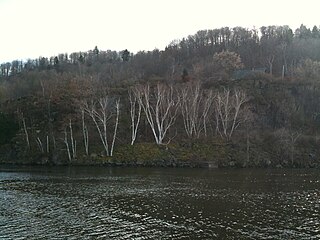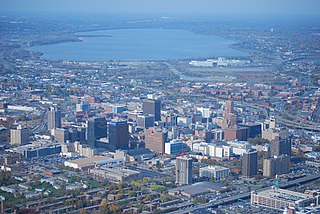 W
WThe Mohawk & Hudson Railroad was the first railroad built in the state of New York and one of the first railroads in the United States. It was so-named because it linked the Mohawk River at Schenectady with the Hudson River at Albany. It was conceived as a means of allowing Erie Canal passengers to quickly bypass the circuitous Cohoes Falls via steam powered trains.
 W
WAlbion is a town in Orleans County, New York, United States. The population was 8,468 at the 2010 census. The town was named after a village in the town.
 W
WThe Black Rock Lock located in Buffalo, New York is 650 feet (200 m) in length and 70 feet (21 m) wide. There is only one chamber and the total weight of the gate is 480 tons. The lock has been a part of Black Rock since the state of New York built the Erie Canal in 1833.
 W
WBridge 8, known locally as the Rexford Bridge, is a two-lane bridge crossing the Mohawk River northeast of the city of Schenectady in New York, United States. It carries New York State Route 146 (NY 146) from Schenectady County to Rexford, a hamlet in the Saratoga County town of Clifton Park. The bridge was designed by the New York State Department of Public Works and opened in 1965. It has a total length of 727 feet (222 m) and a main span of 266 feet (81 m).
 W
WBridge 10 over the Erie Canal and Mohawk River in Schenectady. Bridge 10 is a railroad bridge used by the Canadian Pacific Railway. The rails on the bridge were realigned as part of a clearance project in the late 1990s. The double track was removed and replaced by a single set of rails in the center of the bridge. This was to allow the passage of very large steam turbine parts to be moved by rail from Schenectady's General Electric to the Port of Albany.
 W
WBrighton is a town in Monroe County, New York, USA. The population was 36,609 at the 2010 census.
 W
WBuffalo is the second-largest city in the U.S. state of New York and the largest city in Western New York. As of 2019's census estimates, the city proper population was 255,284. The city is the county seat of Erie County and serves as a major gateway for commerce and travel across the Canadian border, forming part of the bi-national Buffalo Niagara Region and Buffalo–Niagara Falls metropolitan area. As of 2018, the Buffalo-Niagara Falls metropolitan area had a population of 1,130,152; the combined statistical area, which adds Cattaraugus County, had a population of 1,215,826. The Buffalo area was inhabited before the 17th century by the Native American Iroquois tribe and later by French colonizers. The city grew significantly in the 19th and 20th centuries as a result of immigration, the construction of the Erie Canal and rail transportation, and its close proximity to Lake Erie. This growth provided an abundance of fresh water and an ample trade route to the Midwestern United States while grooming its economy for the grain, steel and automobile industries that dominated the city's economy in the 20th century. Since the city's economy relied heavily on manufacturing, deindustrialization in the latter half of the 20th century led to a steady decline in population. While some manufacturing activity remained following the Great Recession, Buffalo's economy has transitioned to service industries with a greater emphasis on healthcare, research and higher education including being home to a top research university, the University at Buffalo. Buffalo is on the eastern shore of Lake Erie, at the head of the Niagara River, 16 miles (26 km) south of Niagara Falls. Its early embrace of electric power led to the nickname "The City of Light." The city is also famous for its urban planning and layout by Joseph Ellicott, an extensive system of parks designed by Frederick Law Olmsted, as well as significant architectural works. Its culture blends Northeastern and Midwestern traditions, with annual festivals including Taste of Buffalo and Allentown Art Festival, two professional sports teams and a Division I college team and a thriving and progressive music and arts scene.
 W
WThe Canandaigua Outlet is a main tributary which feeds the Erie Canal and Clyde River in Wayne County, New York, United States. It begins at Canandaigua Lake in nearby Ontario County and flows approximately 34 miles (55 km) north before emptying into the Erie Canal in the hamlet of Lyons. A number of tributaries feed the Canandaigua Outlet along its route. It is the primary outflow for Canandaigua Lake.
 W
WDeWitt Clinton, whose name was almost always spelled De Witt during his lifetime and until the late 20th century, was an American politician and naturalist who served as a United States Senator, Mayor of New York City, and as the sixth Governor of New York. In this last capacity, he was largely responsible for the construction of the Erie Canal. Clinton was a major candidate for the American presidency in the election of 1812, challenging incumbent James Madison.
 W
WThe Clyde River is a main tributary which feeds the Seneca River in Seneca County, New York, United States. It begins at the hamlet of Lyons in nearby Wayne County and meanders for approximately 27 miles from west to east before emptying into the Seneca River in the town of Tyre at Montezuma National Wildlife Refuge. Much of the original river has been channeled through to form part of the Erie Canal. A number of tributaries feed the Clyde River along its route.
 W
WCohoes Falls [Kahon:ios, Mohawk for "Canoe Falls"] is a waterfall on the Mohawk River shared by the city of Cohoes and the town of Waterford, New York, United States. Discovered by the indigenous people, the falls were called Ga-ha-oose or Ga-ho'n'-yoos by the Mohawks, which is believed to mean "The Place of the Falling Canoe." Cohoes historian Arthur Masten wrote in his 1880 history that the phrase might mean "Potholes in the River," referring to the potholes that appear in the riverbed when it is dry. In the oral tradition of the Haudenosaunee (Iroquois), the Cohoes Falls are the site where The Great Peacemaker, performed a feat of supernatural strength, convincing the Mohawk people to become the founders of the Iroquois League of Nations or Confederacy. Some historians believe the Mohawks launched the Confederacy as early as 1142 CE, though other experts report dates ranging from 1450–1650.
 W
WCrescent Bridge is a 1,229-foot (375 m) bridge over the Mohawk River and the Erie Canal. It is in Crescent, New York, a hamlet in the town of Halfmoon in southern Saratoga County on the northern side of the Mohawk River. The Crescent Bridge carries U.S Route 9 over the Mohawk River between the towns of Colonie in Albany County and Halfmoon.
 W
WCrescent is a hamlet in the town of Halfmoon, New York. It lies on the north bank of the Mohawk River in Saratoga County.
 W
WDurhamville is a hamlet located in Oneida County, New York. The population was 584 as of the 2010 census.
 W
WFairport is a village located in the Town of Perinton, which is part of Monroe County, New York. Fairport is a suburb 9 miles (14 km) east of Rochester. It is also known as the "Crown Jewel of the Erie Canal". In 2005 it was named as one of the "Best Places to Live" by Money Magazine. The population of the Village of Fairport is 5,353 as of the 2010 census.
 W
WThe Flight of Five Locks on the Erie Canal in Lockport, New York is a staircase lock constructed to lift or lower a canal boat over the Niagara Escarpment in five stages.
 W
WFort Hunter is a hamlet in the Town of Florida in Montgomery County, New York, west of the capital at Albany, on the south bank of the Mohawk River and on the northeast bank of Schoharie Creek.
 W
WGanargua Creek, also known as Mud Creek, is a main tributary which feeds the Erie Canal and Clyde River in Wayne County, New York, United States. The creek begins just east of the village of Victor in nearby Ontario County and meanders approximately 34 miles from west to east before emptying into the Erie Canal in the hamlet of Lyons. Ganargua Creek is actually split into two sections as it runs concurrent with the Erie Canal for about 3 miles near the village of Palmyra. Numerous tributaries feed Ganargua Creek along its route.
 W
WThis article documents the history of Rochester, New York, in western New York State. Settlement began in the late 18th century, and the city flourished with the opening of the Erie Canal. It became a major manufacturing center, and attracted many Italians, Germans, Irish and other immigrants, as well as a dominant group of Yankees of New England origin. The Yankees made Rochester the center of multiple reform movements, such as abolitionism and women's rights. It was famous as the center of the American photography industry, with headquarters of Eastman Kodak. In the 1970s it became fashionable to call the industrial cities along the Great Lakes 'rustbelt cities' following the move away from steel, chemical and other hard goods manufacturing. Rochester, with the presence of Ritter-Pfaulder, Bausch and Lomb, Eastman Kodak, Xerox, Gannett and other major industries, defied the trend for many decades following WWII.
 W
WLake Erie is the fourth-largest lake of the five Great Lakes in North America, and the eleventh-largest globally if measured in terms of surface area. It is the southernmost, shallowest, and smallest by volume of the Great Lakes and therefore also has the shortest average water residence time. At its deepest point Lake Erie is 210 feet deep.
 W
WLockport is a city and the county seat of Niagara County, New York, surrounded by the town of Lockport. The population was 21,165 at the 2010 census, with an estimated population of 20,305 as of 2019. It is named from a set of Erie Canal locks within the city. It is part of the Buffalo–Niagara Falls Metropolitan Statistical Area.
 W
WLockport is a town in Niagara County, New York, United States. The population was 20,529 at the 2010 census. The name is derived from the series of canal locks on the Erie Canal. The locks lift boats from the lowland of Lake Ontario past the Niagara Escarpment.
 W
WThe popular song "Low Bridge, Everybody Down" was written in 1905 by Thomas S. Allen after Erie Canal barge traffic was converted from mule power to engine power, raising the speed of traffic. Also known as "Fifteen Years on the Erie Canal", "Fifteen Miles on the Erie Canal", "Erie Canal Song", "Erie Barge Canal", and "Mule Named Sal", the song memorializes the years from 1825 to 1880 when the mule barges made boomtowns out of Utica, Rome, Syracuse, Rochester, and Buffalo, and transformed New York into the Empire State.
 W
WMacedon is a hamlet located in the Town of Macedon in Wayne County, New York, United States. As of the 2010 census, the hamlet had a total population of 1,523. It is in the south-central part of the town and is southeast of Rochester. Macedon was an incorporated village from 1856 to 2017.
 W
WMedina is a village in the Towns of Shelby and Ridgeway in Orleans County, New York, United States. The population was 6,065 at the 2010 census, making it the county's most populous municipality. The village was named by its surveyor, Ebenezer Mix. It is part of the Rochester Metropolitan Statistical Area. The Medina zip code, 14103, encompasses the village of Medina and the surrounding towns of Ridgeway and Shelby. The United States Census Bureau estimates the 2017 population of this area to be 17,234.
 W
WThe Mohawk & Hudson Railroad was the first railroad built in the state of New York and one of the first railroads in the United States. It was so-named because it linked the Mohawk River at Schenectady with the Hudson River at Albany. It was conceived as a means of allowing Erie Canal passengers to quickly bypass the circuitous Cohoes Falls via steam powered trains.
 W
WMoss Island is an island in Little Falls, New York, located between the Mohawk River and the New York State Barge Canal. It is composed of an igneous intrusion of syenite, and became an island when canal locks were built so boats could avoid the 40-foot (12 m) falls. It is known for its large 40–50-foot (12–15 m) deep potholes as well as being popular with local rock climbers. It was declared a National Natural Landmark in 1976. Efforts by the local community to turn Moss Island into a New York State Park were begun in 2008.
 W
WThe New York Central Railroad was a railroad primarily operating in the Great Lakes and Mid-Atlantic regions of the United States. The railroad primarily connected greater New York and Boston in the east with Chicago and St. Louis in the Midwest along with the intermediate cities of Albany, Buffalo, Cleveland, Cincinnati, Detroit, and Syracuse. New York Central was headquartered in New York City's New York Central Building, adjacent to its largest station, Grand Central Terminal.
 W
WNewark is a village in Wayne County, New York, U.S., 35 miles (56 km) south east of Rochester and 48 miles (77 km) west of Syracuse. The population was 9,145 at the 2010 census. The Village of Newark is in the south part of the Town of Arcadia and is in the south of Wayne County. It is the most populated community in Wayne County.
 W
WNiska Isle, despite its name, is not an island, but a peninsula in the town of Niskayuna, New York. Niska Isle is along the Mohawk River's south shore, with a back bay and swamp that surrounds it to the south.
 W
WPalmyra is a village in Wayne County, New York, United States. The population was 3,536 at the 2010 census. The village, along with the town, is named after Palmyra in present-day Syria.
 W
WPittsford is a village in Monroe County, New York, United States. The population was 1,355 at the 2010 census. It is named after Pittsford, Vermont, the native town of a founding father.
 W
WRome is a city in Oneida County, New York, United States, located in the central part of the state. The population was 33,725 at the 2010 census. Rome is one of two principal cities in the Utica–Rome Metropolitan Statistical Area, which lies in the "Leatherstocking Country" made famous by James Fenimore Cooper's Leatherstocking Tales, set in frontier days before the American Revolutionary War. Rome is in New York's 22nd congressional district.
 W
WSpencerport is a village in Monroe County, New York, United States, and a suburb of Rochester, New York. The population count was 3,601 at the 2010 census.
 W
WSyracuse is a city in and the county seat of Onondaga County, New York, United States. It is the fifth-most populous city in the state of New York following New York City, Buffalo, Rochester, and Yonkers.
 W
WTeoronto Block Historic District is a national historic district located in the Frankfort neighborhood of Rochester in Monroe County, New York. The district consists of 10 contributing buildings originally built beginning in 1844, with later additions and modifications. It is reflective of Rochester's early commercial and industrial development as an Erie Canal-oriented boom town. It includes a block long group of three story, brick commercial buildings, known as the Teoronto-Smith Block. They consist of nine five bay buildings with a continuous gable roof. Also in the district is a set of attached commercial / industrial buildings.
 W
WThe Northern Gateway for antebellum trade was the primary trade route connecting the Midwestern United States with the Northeast and the Atlantic Ocean. The gateway's canals, rivers, and railroads drastically altered the makeup of America's economy, culture, and population distribution. As rail and waterway technology improved, the Northern Gateway became the preeminent trade conduit in the nation. It helped spur the growth of both eastern and western cities. Settlers rapidly began to settle in the burgeoning towns of the many trade points all along the gateway's route. It allowed goods and information to travel at unprecedented rates, which, in turn, completely re-vamped the style and processes of American culture and economics.
 W
WUtica Canal Terminal Harbor, commonly known as Utica Harbor, is a small man-made harbor in Utica, New York|Utica]], Oneida County, New York. The harbor was once connected to the Mohawk River and the Erie Canal by the Utica Harbor Lock, which is now permanently closed and used only for flood control.
 W
WWatervliet is a city in Albany County in the U.S. state of New York. The population was 10,254 as of the 2010 census. Watervliet is north of Albany, the capital of the state, and is bordered on the north, west, and south by the town of Colonie. The city is also known as "the Arsenal City".
 W
WThe West Shore Railroad was the final name of a railroad that ran from Weehawken, New Jersey, which is across the Hudson River from New York City, north along the west shore of the river to Albany, New York, and then west to Buffalo. It was organized as a competitor to the New York Central and Hudson River Railroad, but was soon taken over by that company.
 W
WCanvass White was an American engineer and inventor. He was chief engineer at the Delaware and Raritan Canal and he patented Rosendale cement, which became the dominant cement in the United States until 1900.
 W
WWhiteside, Barnett and Co. Agricultural Works, also known as Canal-Front Warehouse, is a historic factory and warehouse complex located at Brockport in Monroe County, New York. It is a largely intact and rare surviving example of the brownstone industrial building that once lined the banks of the Erie Canal at Brockport. It is also the only surviving building related to the local reaper manufacturing industry. The existing buildings were built between 1850 and 1852 for the Agricultural Works in Brockport, later known as Whiteside, Barnett and Co. The property was later used as a lumberyard from about 1880 to 1904 and as a cannery until 1945.